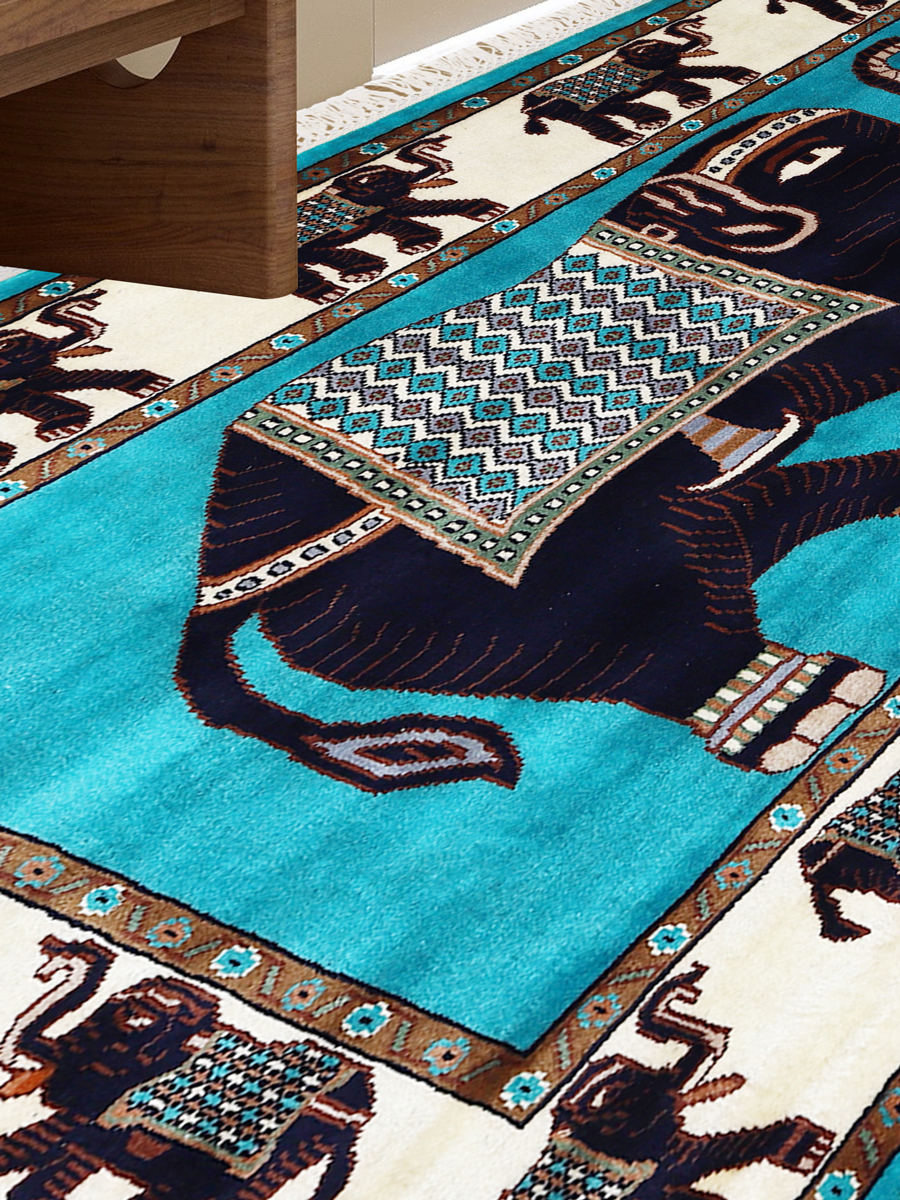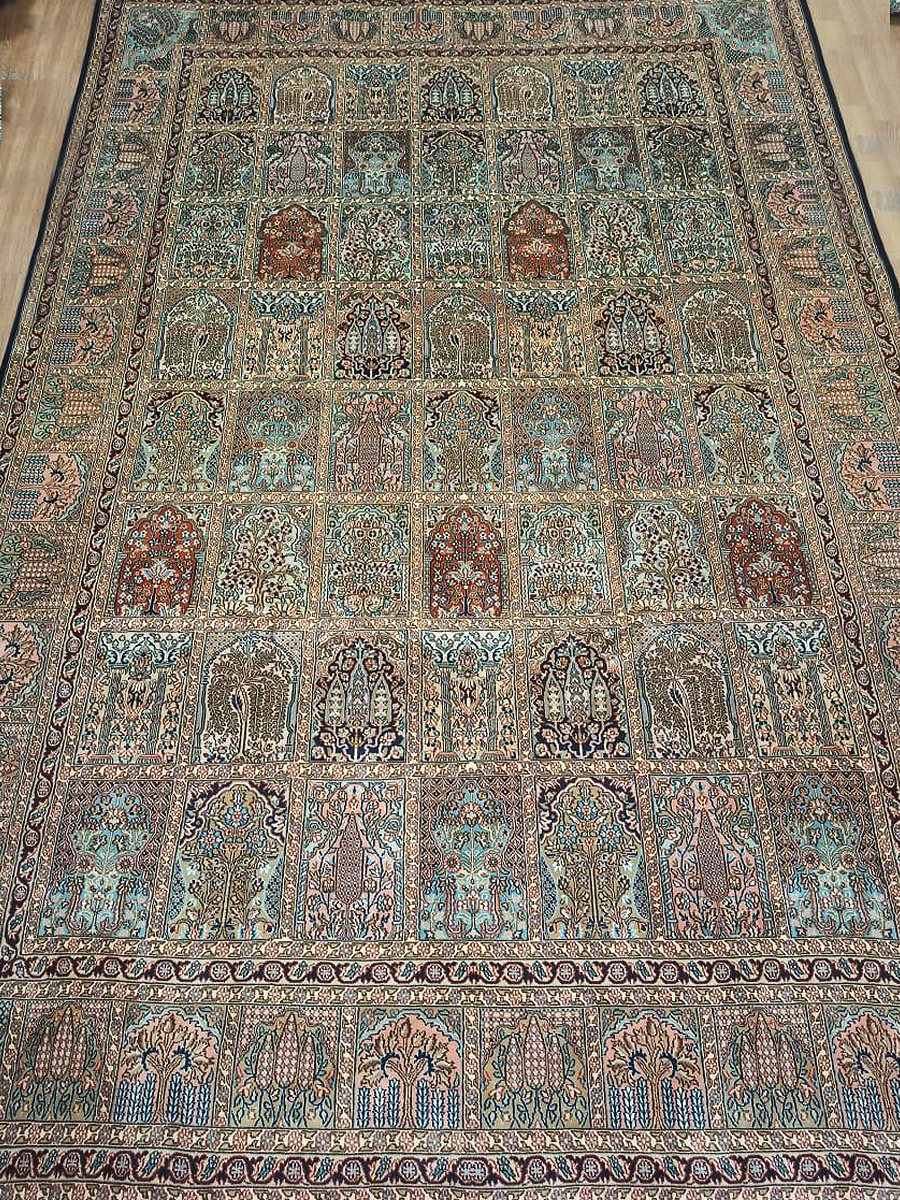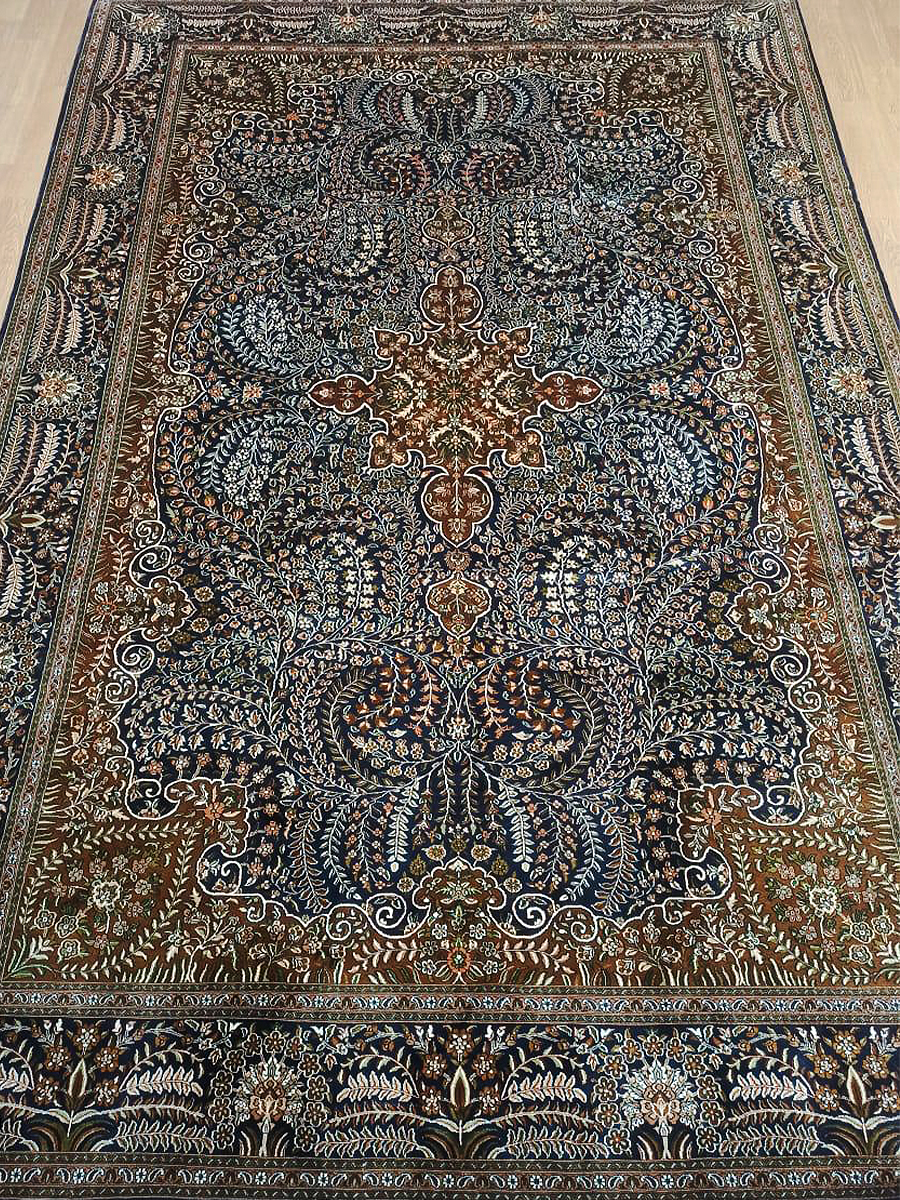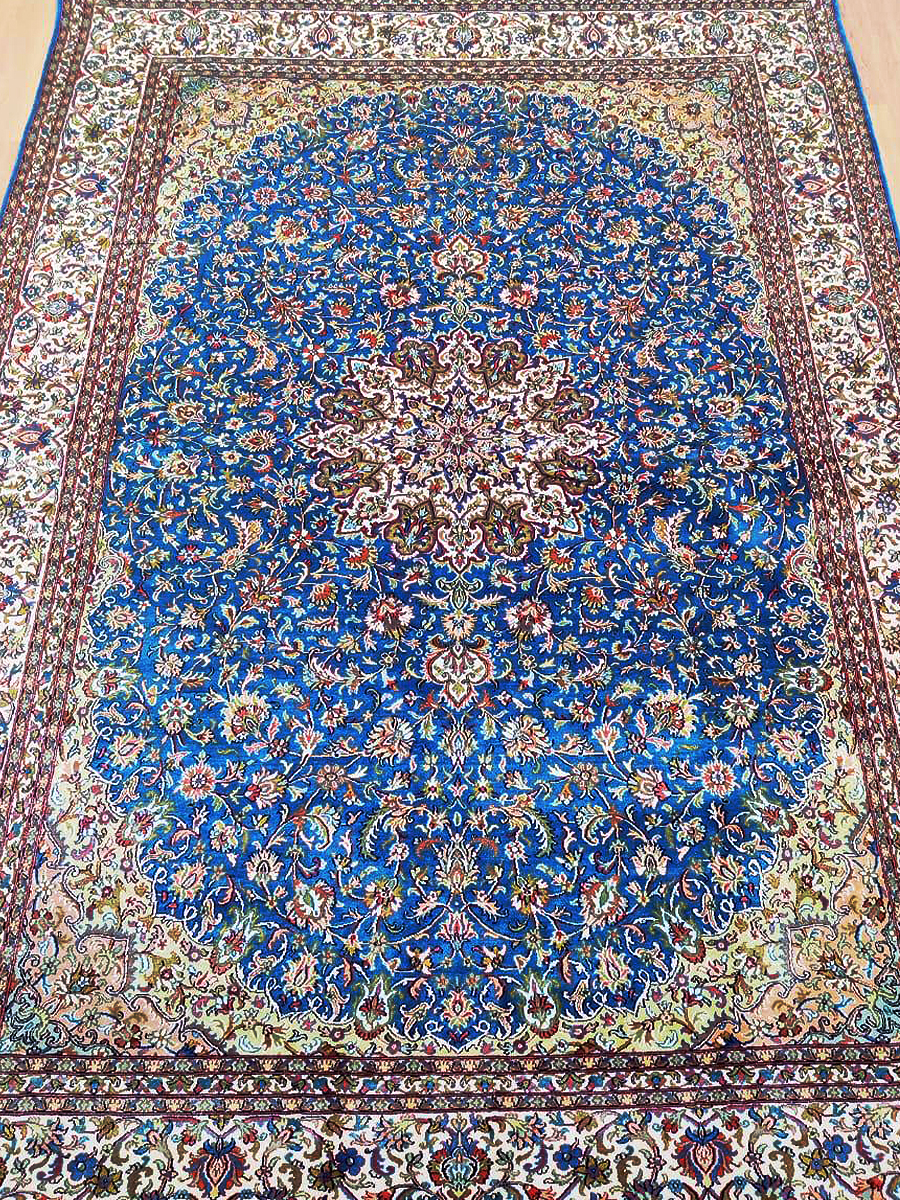The Making Of The Precious ‘Flying Carpets’
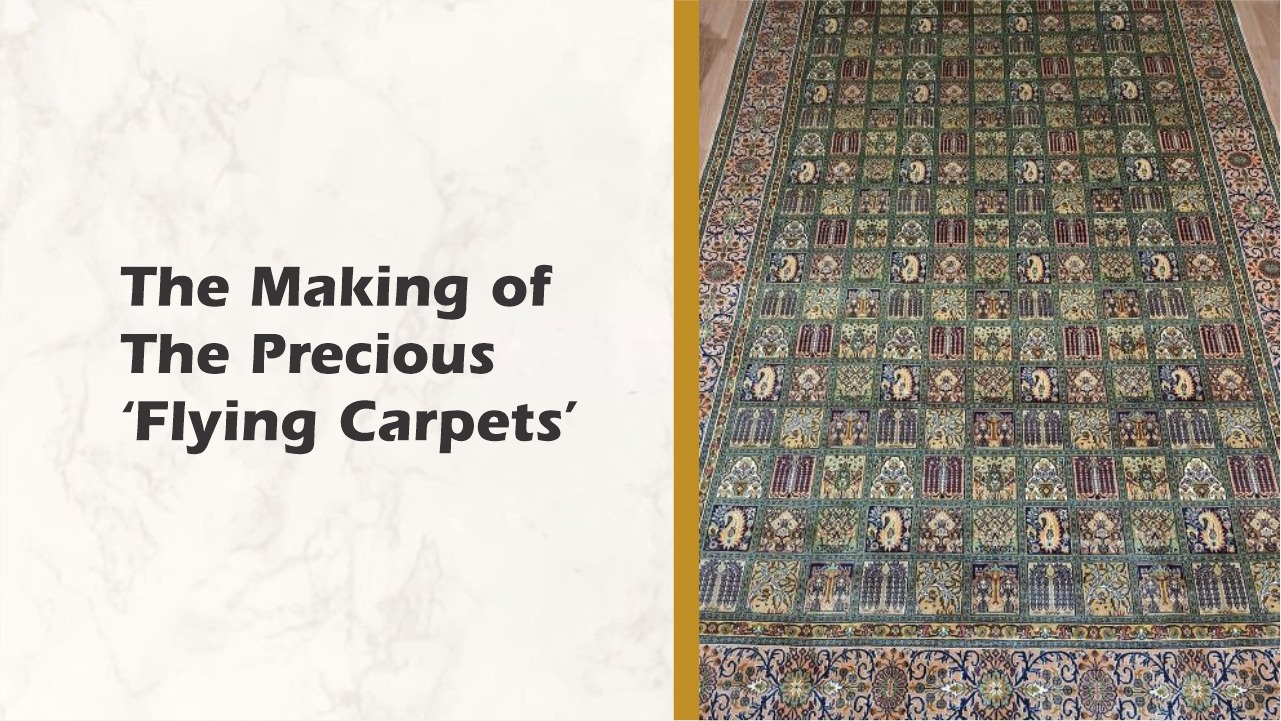
The crest jewel of India, Kashmir, is also one of the foremost geographies in the world where the ancient art of handcrafting exquisite carpets is preserved and practised to this day. Hand Knotted Kashmiri carpets are symbols of true luxury and represent the pinnacle of craftsmanship, artistry, and tradition. Owning one makes us understand why folklore is rich with flying carpets - you are sure to be on cloud nine possessing it!
Kashmiri hand-knotted silk carpets are not just carpets, they are pieces of art that are crafted by skilled artisans with utmost care and precision. It all begins with sourcing and the highest quality silk imported from other regions of India or neighbouring countries. The silk is then carefully sorted and spun into fine threads that are used to weave the carpets. The weavers use a hand-knotting technique that has been passed down through generations, where each knot is tied by hand to create the intricate and highly detailed patterns.
From Inspiration To Imprint
The designs of the flying carpets are conceived in meditative moments of intense creativity. This design is first sketched on paper and then transferred onto graph paper, which serves as a guide for the weavers. The weavers then begin the process of knotting the silk threads, following the pattern on the graph paper. The process is slow and joyful, akin to the brushstrokes of a maestro, as each knot must be tied with precision and care to ensure the final product is flawless. Once the weaving is complete, the carpet is carefully washed and dried to enhance the sheen and lustre of the silk. The final step is the finishing, where the edges of the carpet are carefully bound and fringes are added to complete the look.
Hand knotted New Zealand wool carpet Royal Elephant motiff
The intricacy and quality of a hand-knotted Kashmiri carpet are determined by a number of factors, including the quality and type of silk or wool used, the density of knots, the complexity of the design, and the overall size of the carpet. For example, a carpet with a higher knot count will be more intricate and expensive than one with a lower knot count, as more knots per square inch require more time and effort to weave. Typically, a carpet can take anywhere between a minimum of three months to upwards of two years to make, depending on the complexity and size of the particular carpet. Thus, it requires a significant amount of time and effort from the artisan to create each unit, which, apart from the exceptional craftsmanship, are some of the reasons why these carpets are considered royalty in the art of carpet making.
Silken Luxury
Silk is the queen of luxurious materials when it comes to carpet making. It has been woven into tapestries, rugs and fine fabrics for more than 4000 years. According to legend, an empress accidentally dropped a cocoon into a cup of hot tea. The heat melted the gum holding the cocoon together, and she discovered that the cocoon unravelled into one continuous fiber.
Being a naturally lustrous and shiny fibre, silk adds a beautiful sheen to carpets, making them look rich, sensual and elegant.
But what makes silk fabric look so spectacular? It is the structure of the fiber. Silk is produced by silkworms, basically caterpillars, belonging to two families: Bombycidae (the commercial silkworm) and Saturniidae (the wild silkworm). The most common source of silk, Bombyx mori, is raised domestically, but only where there are mulberry leaves.
9' x 6' Hand knotted silk on silk luxury carpet from Kashmir - Tree of Life (with GI certification)
On the other hand, wild silkworms are more robust. It produces a tougher, rougher silk, which is not as easily bleached and dyed as the mulberry silk. The leaves these silkworms eat are full of tannin that colors the silk, giving it a beige look. Wild silk is usually called Tussah silk. However, there are many kinds of wild silks, each with its own characteristics.
Speaking of strength, silk possesses a high tensile strength, be it Tussah silk, other wild silk or mulberry silk. It is strong and durable, despite its delicate appearance, thus making silk carpets long-lasting, with an ability to withstand wear and tear for long periods of time.
Quality Matters Most
A good carpet is a work of art that combines quality materials, skilled construction, exceptional artisanship and long-lasting durability. As a buyer you should look for the following when selecting a carpet.
- Material: The most luxurious carpets are made from natural materials such as silk, wool, or a blend of both. Wool is durable and soft, while silk adds a luxurious sheen, a delicate texture, and is also extremely durable.
- Construction: Hand-knotted carpets are the most effort-intensive and time-consuming, but they are also the most durable and of the highest quality. The higher the number of knots per square inch of carpet, the higher the quality of a hand-knotted carpet. Hand-tufted and machine-made carpets are less expensive, but they may not have the same level of durability and craftsmanship. Buyers should look for carpets with tight knots, consistent weaving, and straight edges.
- Durability: A thicker, denser carpet will be more resistant to wear and tear, last longer and also feel softer. Buyers should also look for carpets with a high pile density, which means that there are more fibres per square inch.
- Design: Look for carpets with intricate patterns, rich colours, and unique designs that complement the décor of the room and reflect your personal style. Handmade carpets, naturally, have more unique and intricate designs.
- Maintenance: Natural fibres such as wool or silk are generally more resistant to stains and spills, but they may require a bit of extra care to maintain their appearance.
In 2008, the Indian government granted the Geographical Indication (GI) tag to Kashmiri carpets to protect the traditional knowledge, skills, and reputation associated with Kashmiri carpets. The GI tag for Kashmiri carpets recognizes that the carpets are unique to the region of Kashmir and are made using traditional methods that have been passed down from generation to generation. It also helps to protect the local artisans and weavers who have been making these carpets for centuries, ensuring that their traditional knowledge and skills are preserved and passed onto future generations.
9' x 6' Hand knotted silk on silk luxury carpet from Kashmir - Kashan 2 (with GI certification)
A Rich And Proud Heritage
Carpet making is a rich and diverse craft that has been practised in many different regions of the world for centuries. Though wool and silk are the materials used commonly, each region has its unique style, designs, and techniques, which have been influenced by local cultures, traditions, and history.
Carpet making in Persia (Iran) dates back over 2,500 years. These carpets are known for their intricate designs, which often include floral and geometric patterns. The most famous Persian carpet types include Tabriz, Kashan, and Isfahan. Then there are the Chinese carpets dating back to the Han dynasty (206 BC – 220 AD), featuring traditional Chinese designs that include dragons, flowers, and birds. Chinese carpets like the Ningxia, Peking, and Tibet are also known for their high knot density, which makes them incredibly durable.
The history of carpet making in Turkey dates back to the 13th century and these carpets are known for their bold and colourful designs, which often feature floral and geometric patterns. Turkish carpets are also known for their durability. Some of the most famous Turkish carpet types include Hereke, Oushak, and Kayseri. India is a relatively new entrant in carpet making and the art is about 500 years old, influenced by Persian and Mughal styles. Indian carpets are known for their vibrant colours and soft texture. Some of the most famous Indian carpets are from Kashmir, Gwalior, Jaipur and Agra.
Pointers For Carpet Maintenance
Maintaining a luxury carpet is important to ensure that it retains its beauty, durability, and value over time. Here are some tips from the experts.
- Vacuum your carpet regularly to remove dirt, dust, and debris.
- Deal with spills and stains as soon as possible. Blot up the spill with a clean cloth or paper towel, and then use a carpet cleaner specifically designed for your type of carpet. Avoid using harsh chemicals or bleach.
- Have your luxury carpet professionally cleaned every 12 to 18 months, depending on how much foot traffic it receives. Professional cleaners have specialised equipment and cleaning solutions that can remove deep-seated dirt and stains and restore the carpet's natural beauty.
- Rotate your carpet: Rotate your carpet every six months to prevent wear patterns from forming in high-traffic areas and ensuring that the carpet wears evenly over time.
- Place rug pads under your carpet to protect it from wear and tear and prevent slipping. Rug pads also help to absorb shock and reduce noise.
- Protect your luxury carpet from direct sunlight, which can cause fading and damage the fibres. Use window treatments or shades to block out the sun's rays.
You are now an expert and ready to be the proud owner of your own magic carpet! Welcome one into your home and see it become part of your family for decades to come.


 USD
USD  GBP
GBP EUR
EUR AED
AED



